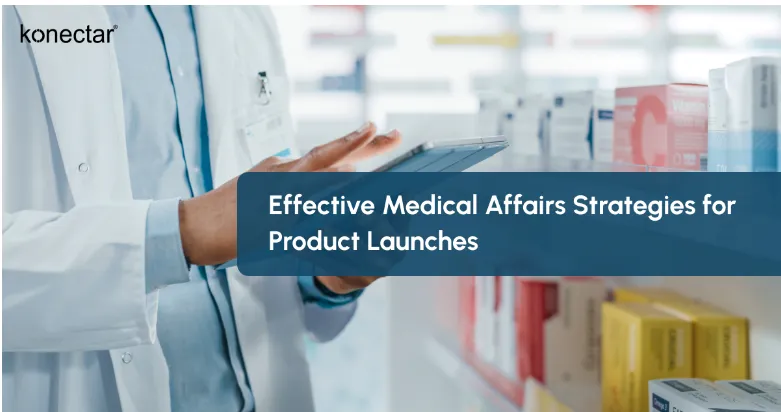03-10-2024
Effective Medical Affairs Strategies for Product Launches

Medical Affairs plays a vital role at every stage of a drug launch. From the initial planning meetings to long-term follow-up, these teams ensure that doctors, payers, and regulators receive clear and accurate scientific information about the product.
Each company’s launch plan is unique, but a few key tactics are effective for nearly everyone. In this article, we’ll look at the most effective Medical Affairs strategies for a smooth, successful launch.
In this article:
- 1. Strategic Pre-Launch Planning - Laying the Groundwork
- 2. Multi-Region Launch Plan & Tracking
- 3. Developing Comprehensive Education Materials
- 4. Engaging Key Opinion Leaders (KOLs) to Enhance Product Launch Strategies
- 5. Post-Launch Performance Monitoring: Ensuring Ongoing Success
- 6. The Takeaway
- 7. FAQs
Product launch excellence can be achieved by charting out the activities and actions to be taken by Medical Affairs. The strategy should be optimal across affiliates, locations, and countries and focus on improving efficiencies, compliance, and best practices. This eventually leads to improvement in product’s reach, health outcomes, brand credibility, and the organization's long-term standing.
Many leading medical affairs companies also collaborate with the Medical Affairs Association to stay aligned with evolving standards.
Strategic Pre-Launch Planning - Laying the Groundwork
Planning for a successful product launch typically begins up to two years before the drug reaches the market. The first step is building a playbook based on in-depth market research. This research should examine factors such as market conditions, competitors’ launch budgets, and product positioning. Choosing a product name, designing labels, and securing trademarks are also key activities to undertake early on.
Multi-Region Launch Plan & Tracking
This is especially true for any medical affairs pharmaceutical team that intends to launch a product in various regions. In such cases, factors such as regional regulation, healthcare practices, competition, and market preferences are considered. Regional alignment should take place 18 months before the launch, as teams need to fulfill various obligations.
Also, promotions in many countries are strictly regulated to avoid misleading and unethical promotion of drugs. For instance, a company must navigate a thorough and complex regulatory framework when launching in the European regions. In such a case, a key authoritative team can be appointed to scrutinize the entire launch process. This ensures that the product, promotions, and the entire launch cycle comply with the regulations.
Developing Comprehensive Education Materials
Developing comprehensive educational materials is imperative before the product launches. For literature aimed at HCPs, they should have more evidence-focused content. Such materials should be backed by all the relevant clinical and research studies. This will help medical professionals understand the drug's mechanism of action, its side effects, etc. The materials can be in the form of peer-reviewed articles, guides, or e-learning modules.
This material should include clear therapy information and clinical data that are easy to access for quick reference.
Engaging Key Opinion Leaders (KOLs) to Enhance Product Launch Strategies
Identifying and engaging top KOLs is the crucial step during a pharma product launch. These KOLs are influential with an extensive network and reach among peers and patients alike. Collaborating with them helps medical teams capitalize on their expertise and popularity, which ultimately benefits the brand value. Identifying relevant HCPs in a specific therapeutic area can be overwhelming. Not to mention, assessing their willingness to endorse your product.
Often, top medical professionals are already working with competitors or don’t have time to take on new commitments. This can make it hard for life sciences teams to find the right experts.
konectar, an AI-powered KOL Management Platform, only enables Medical Affairs with insightful data on top KOLs. The platform can also suggest teams with a list of similar KOLs that have the same expertise and experience to advocate for your brand.
Post-Launch Performance Monitoring: Ensuring Ongoing Success
The first step in performance monitoring begins by outlining the objectives and goals that were set before the launch. These benchmarks serve as a reference point for Medical Affairs for measuring their performance.
⁕ Gathering Relevant Data
This step includes collecting all the relevant data that depicts how the product has fared post-launch. It could comprise HCP and patient feedback, surveys, brand sales, etc.
⁕ Identify Discrepancies
Once data is collected, compare it against the goals set before the launch. This comparison will reveal gaps between what was expected and what actually occurred in areas such as revenue and market reach. By spotting these discrepancies, teams can understand the reasons behind any underperformance.
⁕ Conduct Root Cause Analysis
Root cause analysis may involve examining various factors, such as competition, product pricing, marketing efforts, and market trends. Understanding these factors helps discern why certain goals weren't met.
⁕ Prioritize Improvement Needs
Ranking the areas that require improvement based on their significance is critical to the overall success of the product. Teams must focus on addressing the most critical gaps that are likely to have the greatest impact on performance.
⁕ Develop Action Plans
Creating strategies to close the identified gaps is essential as it will determine the product's long-term haul. These may involve adjusting pricing, redesigning marketing campaigns, etc. The action plans should be targeted to address key performance shortcomings.
⁕ Allocate Resources
Ensure that adequate resources, such as funding, teams, and time, are assigned to implement the action plans. Proper resource allocation is crucial to effectively bridging the identified gaps.
⁕ Monitor and Evaluate Performance
After implementing the changes, closely monitor performance metrics to evaluate the effectiveness of the adjustments. Track whether the gap between the desired and actual results is decreasing over time.
⁕ Iterate and Improve
Finally, use the insights gained from the gap analysis to refine and improve strategies. This iterative process helps ensure the product plan stays aligned with the goals.
The Takeaway
Medical Affairs plays a crucial role in planning and disseminating accurate scientific and clinical information throughout the launch cycle. In the U.S., the medical affairs landscape is changing quickly. There is a growing need to use digital tools and data-driven insights to improve all areas of launch campaigns.
konectar, an AI-powered HCP Management Platform, meets this requirement brilliantly by offering valuable insights into the HCP landscape. To learn how the platform can help streamline HCP engagement and Medical Affairs operations, request a demo of konectar today!
FAQs
- Why is pre-launch planning crucial in pharmaceutical product launches?
Pre-launch planning occurs at least 24 months before the product's actual launch. It involves conducting market research, finalizing product positioning, training teams, and ensuring regulatory approvals. This preparation ensures all stakeholders are ready to meet market demands when the product is launched.
- What role do Key Opinion Leaders (KOLs) play in product launches?
KOLs have extensive influence and reach within the industry. Pharma companies collaborate with such professionals to advocate new therapies through digital and academic platforms, speak at conferences, and publish studies. This helps enhance the product's credibility in the medical community.
- How does Medical Affairs contribute to a successful product launch?
Medical Affairs teams are responsible for accurately communicating the clinical data and product information to healthcare professionals (HCPs), regulatory bodies, and other stakeholders. They play an important role in ensuring compliance and supporting informed decision-making among prescribers.





